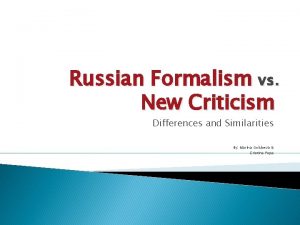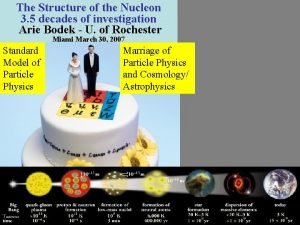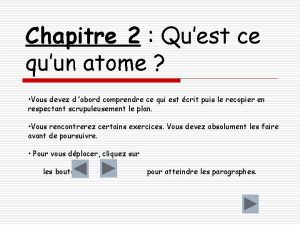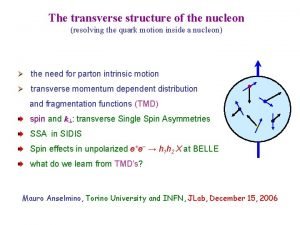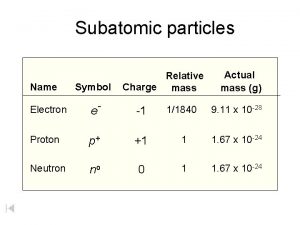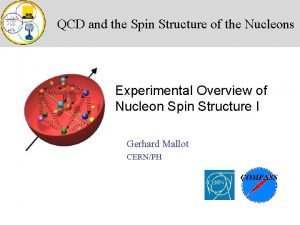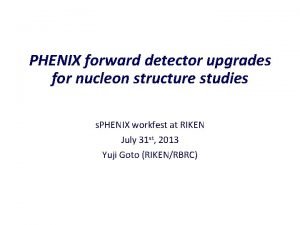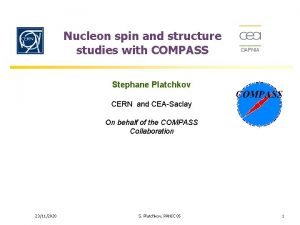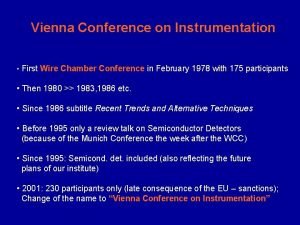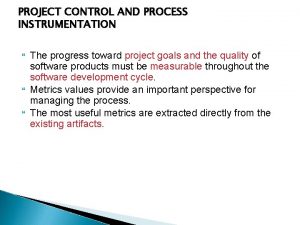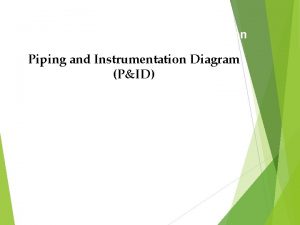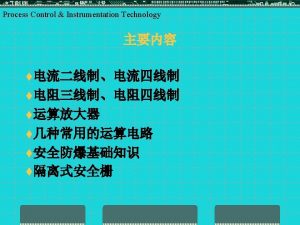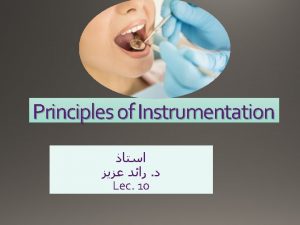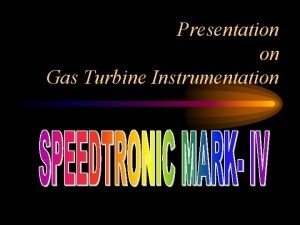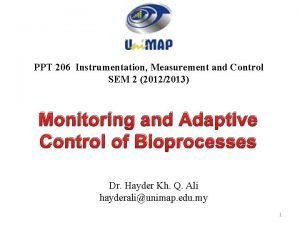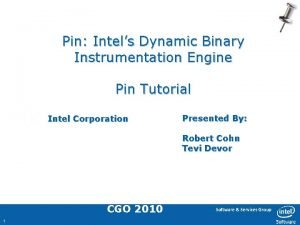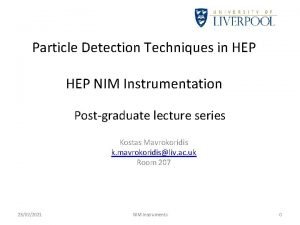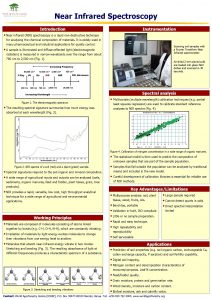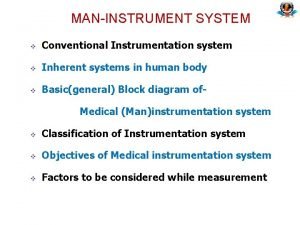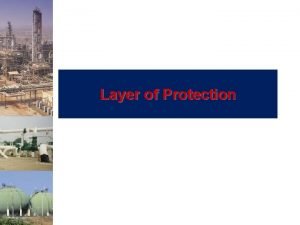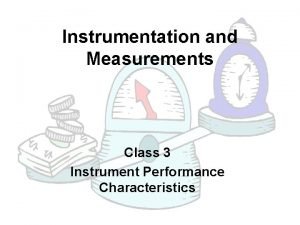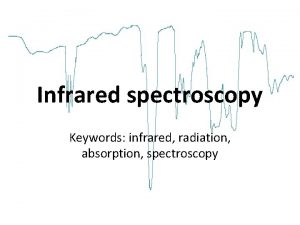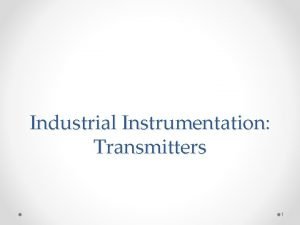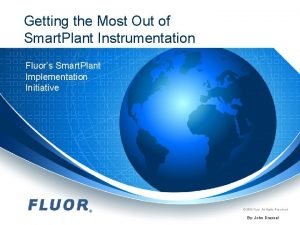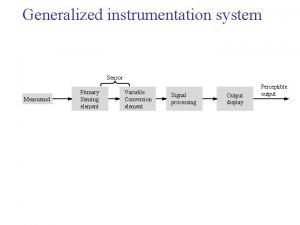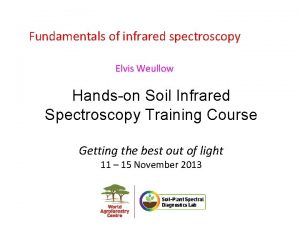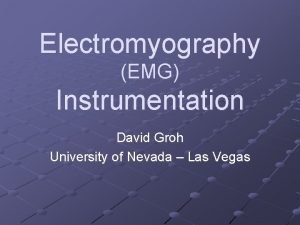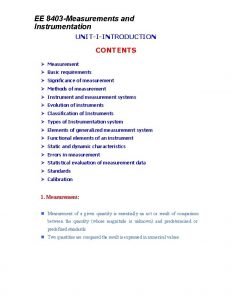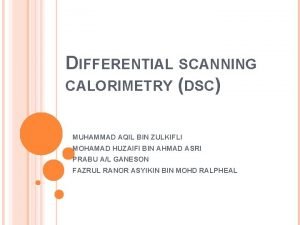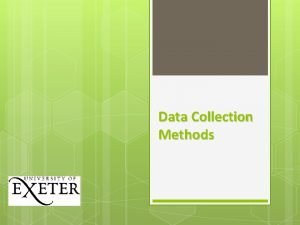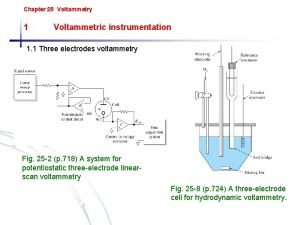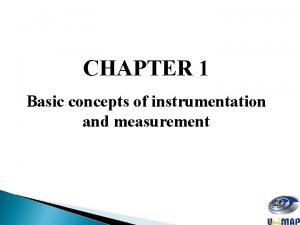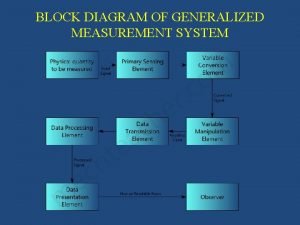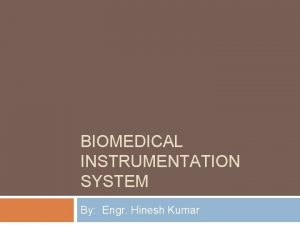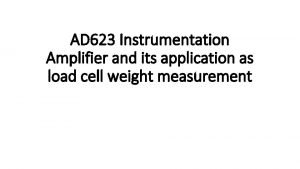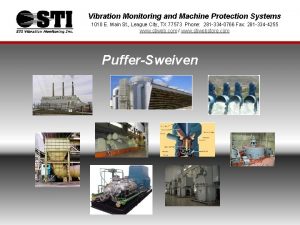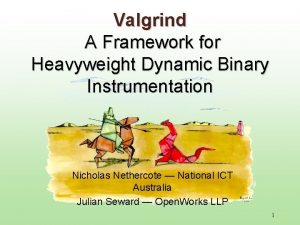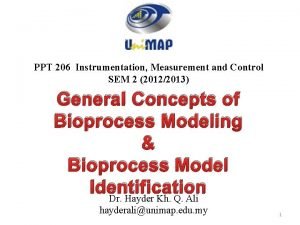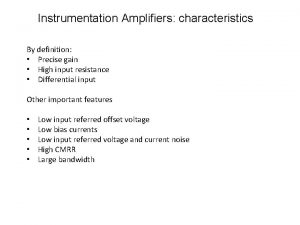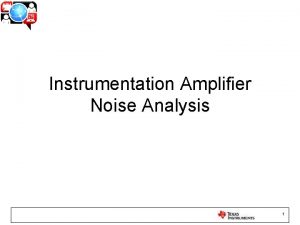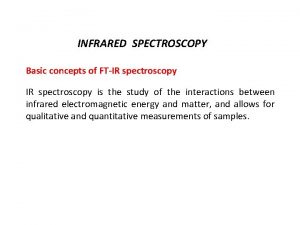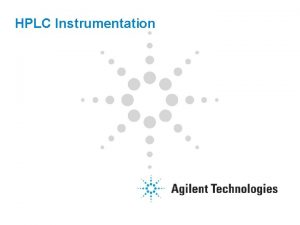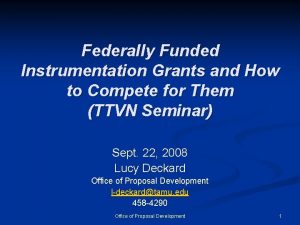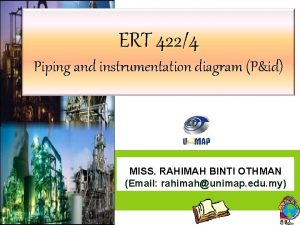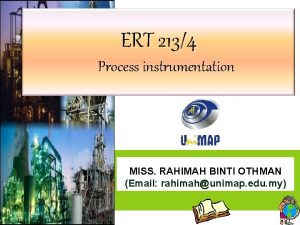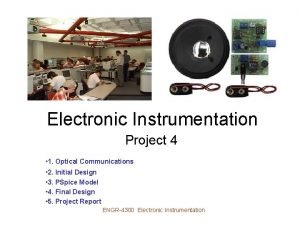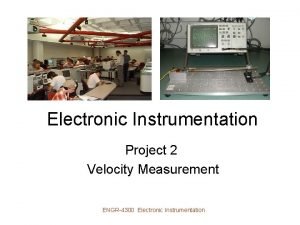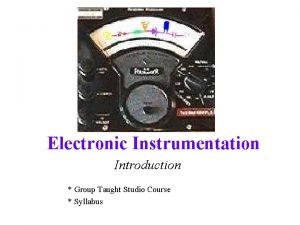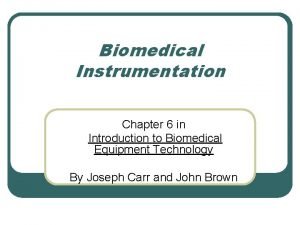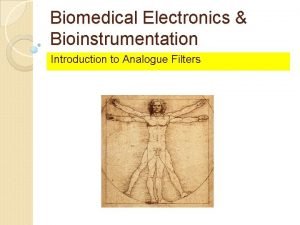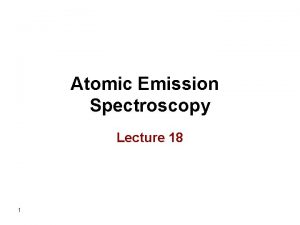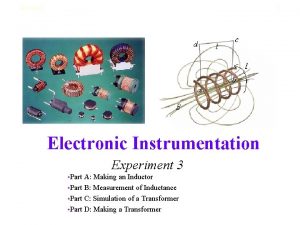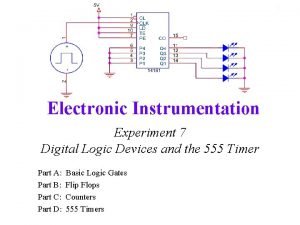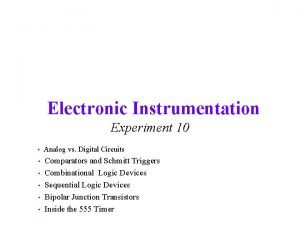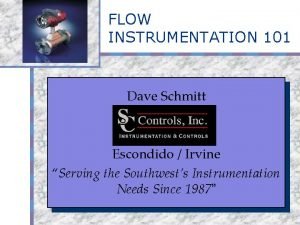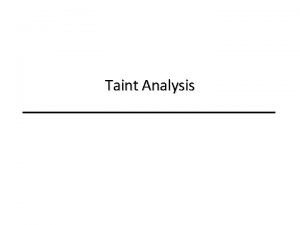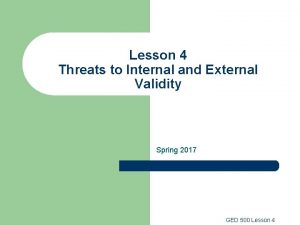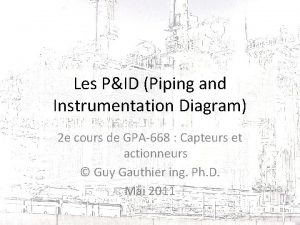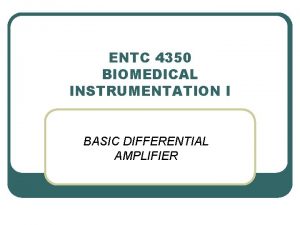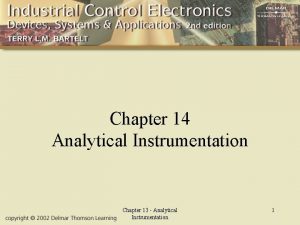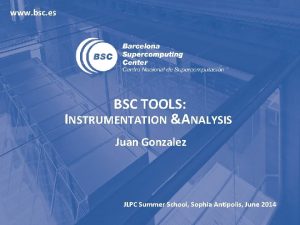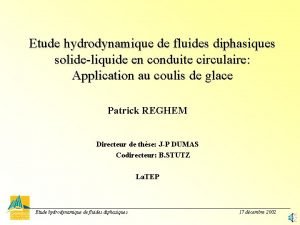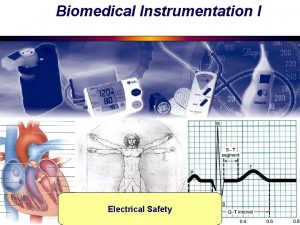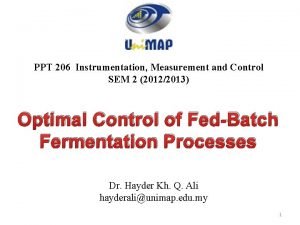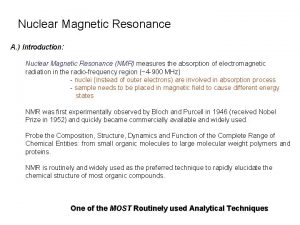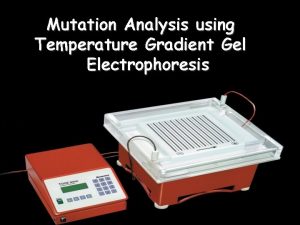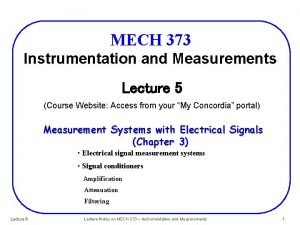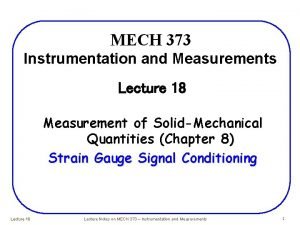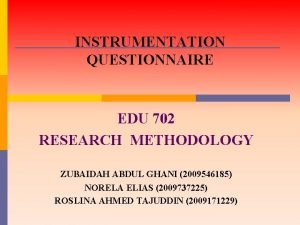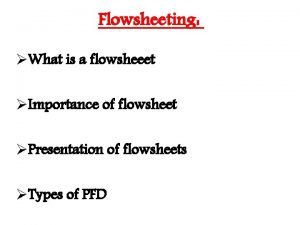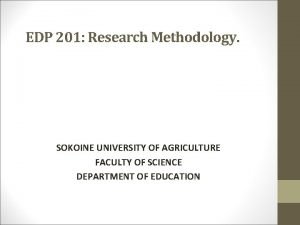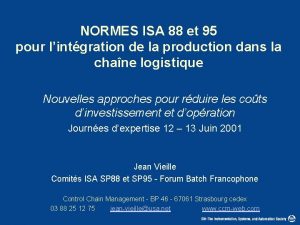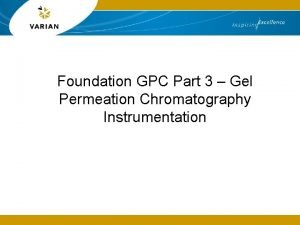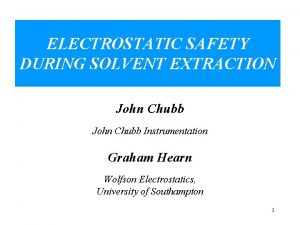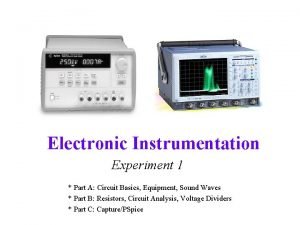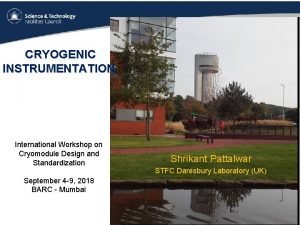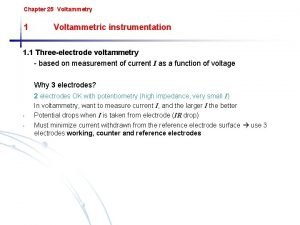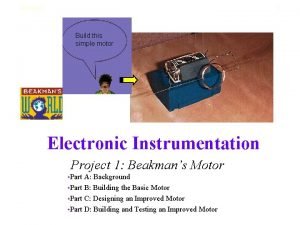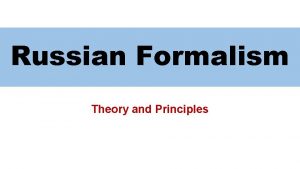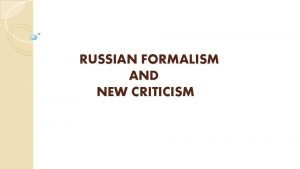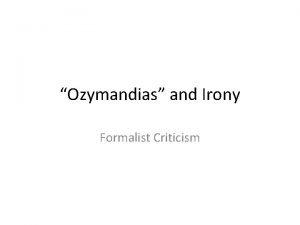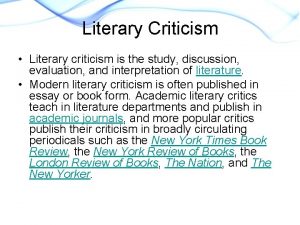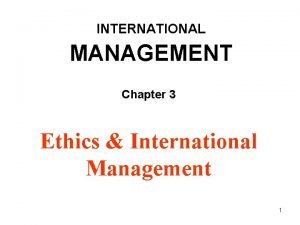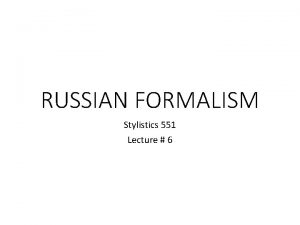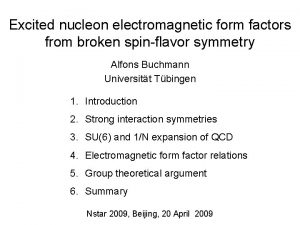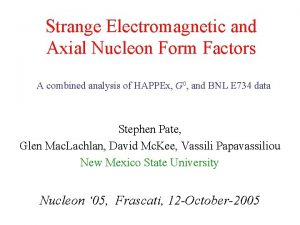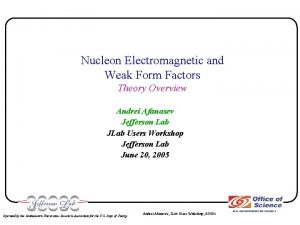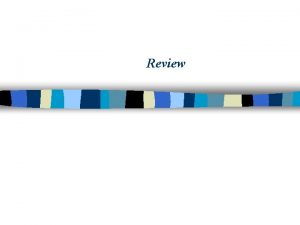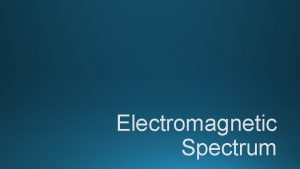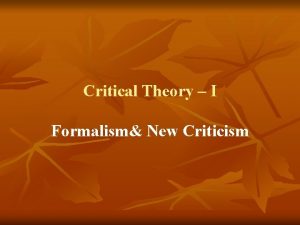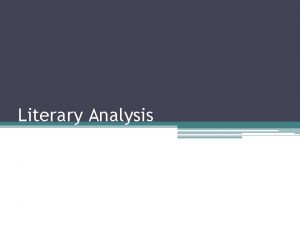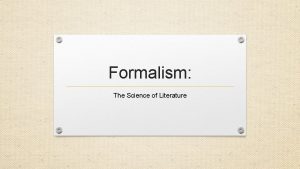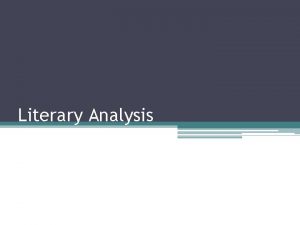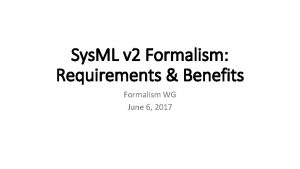Nucleon ElectroMagnetic Form Factors Introduction Formalism Instrumentation Review



























































































































- Slides: 123

Nucleon Electro-Magnetic Form Factors • • • Introduction Formalism Instrumentation Review of data Theory Summary Kees de Jager Jefferson Lab SUSSP 58 August 23 - 27, 2004 Thomas Jefferson National Accelerator Facility Operated by the Southeastern Universities Research Association for the U. S. Department Of Energy SUSSP 58, August 23, 2004, 1

Introduction • Form Factor response of system to probe with wavelength l (or momentum transfer Q), often normalized to that of point-like system Examples: ßscattering of photons by bound atoms ßnuclear beta decay ßX-ray scattering from crystal ßelectron scattering off nucleon Thomas Jefferson National Accelerator Facility Operated by the Southeastern Universities Research Association for the U. S. Department Of Energy SUSSP 58, August 23, 2004, 2

Nucleon Electro-Magnetic Form Factors Ù Fundamental ingredients in “Classical” nuclear theory • A testing ground for theories constructing nucleons from quarks and gluons - probes spatial distribution of charge and magnetization of the nucleon wavelength of probe can be tuned by selecting momentum transfer Q: < 0. 1 Ge. V 2 integral quantities (charge radius, …) 0. 1 -10 Ge. V 2 internal structure of nucleon > 20 Ge. V 2 p. QCD scaling Caveat: If Q is several times the nucleon mass (~Compton wavelength), dynamical effects due to relativistic boosts are introduced, making physical interpretation more difficult Thomas Jefferson National Accelerator Facility Operated by the Southeastern Universities Research Association for the U. S. Department Of Energy SUSSP 58, August 23, 2004, 3

Kinematics Q 2 > 0 space-like region, studied through elastic electron scattering Q 2 < 0 time-like region, studied through creation or annihilation e+ + e- -> N + N or N + N -> e+ + e. In the isovector channel (T = 1) two _ _ pions can contribute, so Q 2 < -4 mπ2 In the isoscalar channel (T = 0) only an odd number of pions can couple, so Q 2 < -9 mπ2 Thomas Jefferson National Accelerator Facility Operated by the Southeastern Universities Research Association for the U. S. Department Of Energy SUSSP 58, August 23, 2004, 4

Formalism Cross section or spin-dependent properties provide information on nucleon vertex In e. N scattering, lepton vertex known from QED Breit frame Lab frame Thomas Jefferson National Accelerator Facility Operated by the Southeastern Universities Research Association for the U. S. Department Of Energy SUSSP 58, August 23, 2004, 5

Formalism Dirac (non-spin-flip) F 1 and Pauli (spin-flip) F 2 Form Factors with E (E’) incoming (outgoing) energy, q scattering angle, k anomalous magnetic moment and t = Q 2/4 M 2 Alternatively, Sachs Form Factors GE and GM In the Breit (centre-of mass) frame the Sachs FF can be written as the Fourier transforms of the charge and magnetization radial density distributions Thomas Jefferson National Accelerator Facility Operated by the Southeastern Universities Research Association for the U. S. Department Of Energy SUSSP 58, August 23, 2004, 6

Early Measurements of GEp • relied on Rosenbluth separation • measure ds/d. W at constant Q 2 • GEp inversely weighted with Q 2, increasing the systematic error above Q 2 ~ 1 Ge. V 2 • At Q 2=6 Ge. V 2 s. R changes by only 8% from e=0 (q=180°) to e=1 (q=0°) if GEp=GMp/µp • Hence, measurement of Gep with 10% accuracy requires 1. 6% cross-section measurement Thomas Jefferson National Accelerator Facility Operated by the Southeastern Universities Research Association for the U. S. Department Of Energy SUSSP 58, August 23, 2004, 7

GEn without Polarization No free neutron target available, early experiments used deuteron Large systematic errors caused by subtraction of proton contribution Elastic e-d scattering Quadrupole Form Factor Platchkov Thomas Jefferson National Accelerator Facility Operated by the Southeastern Universities Research Association for the U. S. Department Of Energy SUSSP 58, August 23, 2004, 8

The Pre-JLab Era • Stern (1932) measured the proton magnetic moment µp ~ 2. 5 µDirac indicating that the proton was not a point-like particle • Hofstadter (1950’s) provided the first measurement of the proton’s radius through elastic electron scattering • Subsequent data (≤ 1993) were based on: Rosenbluth separation for proton, severely limiting the accuracy for GEp at Q 2 > 1 Ge. V 2 • Early interpretation based on Vector-Meson Dominance • Good description with phenomenological dipole form factor: corresponding to r (770 Me. V) and w (782 Me. V) meson resonances in timelike region and to exponential distribution in coordinate space Thomas Jefferson National Accelerator Facility Operated by the Southeastern Universities Research Association for the U. S. Department Of Energy SUSSP 58, August 23, 2004, 9

Global Analysis P. Bosted et al. PRC 51, 409 (1995) Three form factors very similar GEn zero within errors -> accurate data on GEn early goal of JLab First JLab GEp proposal rated B+! Thomas Jefferson National Accelerator Facility Operated by the Southeastern Universities Research Association for the U. S. Department Of Energy SUSSP 58, August 23, 2004, 10

Modern Era Akhiezer et al. , Sov. Phys. JETP 6 (1958) 588 and Arnold, Carlson and Gross, PR C 23 (1981) 363 showed that: accuracy of form-factor measurements can be significantly improved by measuring an interference term GEGM through the beam helicity asymmetry with a polarized target or with recoil polarimetry Had to wait over 30 years for development of • Polarized beam with high intensity (~100 µA) and high polarization (>70 %) (strained Ga. As, high-power diode/Ti-Sapphire lasers) • Beam polarimeters with 1 -3 % absolute accuracy • Polarized targets with a high polarization or • Ejectile polarimeters with large analyzing powers Thomas Jefferson National Accelerator Facility Operated by the Southeastern Universities Research Association for the U. S. Department Of Energy SUSSP 58, August 23, 2004, 11

Instrumentation • • • Polarized beam Beam polarimeters • Møller polarimeter • Compton polarimeter Polarized targets • Polarized hydrogen/deuterium target • Atomic beam source • Polarized helium-3 target Particle detection Recoil polarimeter Thomas Jefferson National Accelerator Facility Operated by the Southeastern Universities Research Association for the U. S. Department Of Energy SUSSP 58, August 23, 2004, 12

How to produce polarized electrons? • • • Use thin layer of semiconductor (Ga. As) Illuminate with highintensity circularly polarized laser light Preferentially excite electrons of one helicity state to conductance band through optical pumping Extract electrons with ~100 k. V potential Transport and bunch electrons to accelerator, while orienting the polarization vector Thomas Jefferson National Accelerator Facility Operated by the Southeastern Universities Research Association for the U. S. Department Of Energy SUSSP 58, August 23, 2004, 13

Photoemission from Ga. As Bare Ga. As surface; Big work function. No electrons Cesium reduces work function. Some electrons Cesium + Oxygen “Negative Electron Affinity”. Many electrons Quantum efficiency: Number of electrons extracted per laser photon Thomas Jefferson National Accelerator Facility Operated by the Southeastern Universities Research Association for the U. S. Department Of Energy SUSSP 58, August 23, 2004, 14

Continuous Electron Beam Accelerator Facility 0. 6 Ge. V linac (20 cryomodules) 1497 MHz 67 Me. V injector (2 1/4 cryomodules) 1497 MHz Gain switched diode lasers 499 MHz, Df = 120 A B RF separators 499 MHz C B A Pockels cell C A Gun B C Double sided septum Thomas Jefferson National Accelerator Facility Operated by the Southeastern Universities Research Association for the U. S. Department Of Energy SUSSP 58, August 23, 2004, 15

Synchronous Photoinjection A B C 1497 MHz 60 degrees • Use pulsed light to extract electrons only when we need them. • This prolongs operating lifetime of the gun. Thomas Jefferson National Accelerator Facility Operated by the Southeastern Universities Research Association for the U. S. Department Of Energy SUSSP 58, August 23, 2004, 16

A good day when… Thomas Jefferson National Accelerator Facility Operated by the Southeastern Universities Research Association for the U. S. Department Of Energy SUSSP 58, August 23, 2004, 17

Photocathode Lifetime Vacuum not perfect. QE degrades via ion backbombardment Thomas Jefferson National Accelerator Facility Operated by the Southeastern Universities Research Association for the U. S. Department Of Energy SUSSP 58, August 23, 2004, 18

Gun Issues Today and Tomorrow • Lifetime at High Current (vacuum issues) • Adequate photocathode QE and polarization • Adequate Laser Power with RF pulse structure • Control of Helicity Correlated Systematics • Beam handling (space charge induced emittance growth) Thomas Jefferson National Accelerator Facility Operated by the Southeastern Universities Research Association for the U. S. Department Of Energy SUSSP 58, August 23, 2004, 19

Møller Polarimeter Basic principle (absolute accuracy 1 -3 %) • Scatter the polarized electron beam off polarized atomic electrons in a magnetized iron foil Advantages: • High analyzing power and small systematics at q. CM = 90° • Large cross section • Two particles ion final states with appr. equal energy • Coincidence between incoming and scattered electron eliminates background Disadvantages • Invasive measurement • Relatively low polarization ~ 8% • Beam current limited (~1 µA) because of target heating • Systematic errors on target polarization • Kinematic distortion from scattering off K, L shell electrons (Levchuk effect) Thomas Jefferson National Accelerator Facility Operated by the Southeastern Universities Research Association for the U. S. Department Of Energy SUSSP 58, August 23, 2004, 20

Møller Polarimeter (cont. ) Thomas Jefferson National Accelerator Facility Operated by the Southeastern Universities Research Association for the U. S. Department Of Energy SUSSP 58, August 23, 2004, 21

Møller Polarimeter (cont. ) Thomas Jefferson National Accelerator Facility Operated by the Southeastern Universities Research Association for the U. S. Department Of Energy SUSSP 58, August 23, 2004, 22

Compton Polarimetry e. E, E’ e- k, k’ s+ s- <Ath>=2 % kmax=340 Me. V • Figure-of-Merit ~ s x A 2 ~ k 2 x E 2 • Differential Measurements yield higher <A> • Absolute accuracy 0. 5 - 1. 5% Thomas Jefferson National Accelerator Facility Operated by the Southeastern Universities Research Association for the U. S. Department Of Energy SUSSP 58, August 23, 2004, 23

Hall A Compton Polarimeter Non-intrusive measurement High current capability tor c e t e nd al Optic Photo cavity Electr tecto e d n o r es Dipol 15 m - 30 cm deflection chicane - Detection of backscattered photons and recoil electrons Thomas Jefferson National Accelerator Facility Operated by the Southeastern Universities Research Association for the U. S. Department Of Energy SUSSP 58, August 23, 2004, 24

Optical setup e beam M 2 Fabry-Perot Cavity Power=1500 W Polarization = 99. 5% M 1 Crossing angle: 23 mrad l/4 plate 240 m. W Laser M 3 IR 1064 nm, CW PDH locking photon power and polarization measurement Thomas Jefferson National Accelerator Facility Operated by the Southeastern Universities Research Association for the U. S. Department Of Energy SUSSP 58, August 23, 2004, 25

Electron detector 4 planes of 48 silicon strips - Width : 650 mm - Energy range for 1 strip: ~ 0. 13% of Ebeam 3 -7 mm gap Allows e-g coincidences Pb. W 04 C. I. P. Thomas Jefferson National Accelerator Facility Operated by the Southeastern Universities Research Association for the U. S. Department Of Energy SUSSP 58, August 23, 2004, 26

Photon calorimeter Scattered photon 5 x 5 Pb. WO 4 scintillators (2 x 2 x 23 cm 3) - Fast response - Compact (c 0=0. 85 cm, RM=2. 2 cm) - Radiation hard Typically, only the central crystal of the 5 x 5 matrix is used Thomas Jefferson National Accelerator Facility Operated by the Southeastern Universities Research Association for the U. S. Department Of Energy SUSSP 58, August 23, 2004, 27

Data taking • 30 Hz Electron helicity flip • 3 min Laser polarization cycle Right-off-Left-off • Signal-to-background > 10 (typ. ) R L Compton spectrum Background spectrum Thomas Jefferson National Accelerator Facility Operated by the Southeastern Universities Research Association for the U. S. Department Of Energy SUSSP 58, August 23, 2004, 28

Summary and Future Plans . . . Compton polarimetry provides non-intrusive high accuracy beam polarization measurements High Gain Fabry-Perot cavity offers superior signal-to-background ratio and better control over systematic errors Present 1064 nm IR laser is adequate down to 3 Ge. V Future plans to improve accuracy down to 1 Ge. V: Ù 532 nm green laser Ù 200 µm pitch electron detector Ù High light-yield calorimeter Thomas Jefferson National Accelerator Facility Operated by the Southeastern Universities Research Association for the U. S. Department Of Energy SUSSP 58, August 23, 2004, 29

Dynamically Nuclear Polarized ND 3 Target Ù Frozen (doped) 15 ND 3 Ù 4 He evaporation refrigerator Ù 5 T polarizing field Ù Remotely movable insert Ù Dynamic nuclear polarization: • Doping with free radicals by radiation damage • In ~5 T field at ~1 K free electrons in radicals are polarized to ~99% • Induce transitions to preferred nuclear spin orientation by RF field • Electrons relax much quicker than nuclei, resulting in ~80% polarization for deuterons and ~30% for protons Thomas Jefferson National Accelerator Facility Operated by the Southeastern Universities Research Association for the U. S. Department Of Energy SUSSP 58, August 23, 2004, 30

Dynamically Nuclear Polarized ND 3 Target Thomas Jefferson National Accelerator Facility Operated by the Southeastern Universities Research Association for the U. S. Department Of Energy SUSSP 58, August 23, 2004, 31

NMR polarimetry • • • Sweep RF frequency Measure absorptive part of response Polarization proportional to signal Thomas Jefferson National Accelerator Facility Operated by the Southeastern Universities Research Association for the U. S. Department Of Energy SUSSP 58, August 23, 2004, 32

Polarized 3 He Target • Polarized 3 He is best approximation of polarized neutron Pn=87 % and Pp=2. 7 % • Requires corrections for nuclear medium, investigated by many theorists • Basic principle: • Optical pumping of Rb, followed by polarization transfer to 3 He through spin-exchange collisions • Target polarization measured by EPR/NMR Ù New technologies and their probable impact • Hybrid alkali spin-exchange optical pumping • Progress with laser technology • Sol-gel coatings and cell production Thomas Jefferson National Accelerator Facility Operated by the Southeastern Universities Research Association for the U. S. Department Of Energy SUSSP 58, August 23, 2004, 33

Polarized 3 He as an effective polarized neutron Thomas Jefferson National Accelerator Facility Operated by the Southeastern Universities Research Association for the U. S. Department Of Energy SUSSP 58, August 23, 2004, 34

Polarized 3 He as an effective polarized neutron Thomas Jefferson National Accelerator Facility Operated by the Southeastern Universities Research Association for the U. S. Department Of Energy SUSSP 58, August 23, 2004, 35

Optical pumping in Rb Thomas Jefferson National Accelerator Facility Operated by the Southeastern Universities Research Association for the U. S. Department Of Energy SUSSP 58, August 23, 2004, 36

Alkali-metal/noble gas spin exchange Thomas Jefferson National Accelerator Facility Operated by the Southeastern Universities Research Association for the U. S. Department Of Energy SUSSP 58, August 23, 2004, 37

Spin-exchange efficiency How many polarized alkali -metal atoms does it take to polarize a 3 He nucleus? It depends on how much angular momentum goes into spin exchange and how much is lost into other processes. Thomas Jefferson National Accelerator Facility Operated by the Southeastern Universities Research Association for the U. S. Department Of Energy SUSSP 58, August 23, 2004, 38

Schematic of JLab polarized 3 He target Thomas Jefferson National Accelerator Facility Operated by the Southeastern Universities Research Association for the U. S. Department Of Energy SUSSP 58, August 23, 2004, 39

JLab target cell Thomas Jefferson National Accelerator Facility Operated by the Southeastern Universities Research Association for the U. S. Department Of Energy SUSSP 58, August 23, 2004, 40

3 He target polarization during E 99 -117 and E 97 -103 Thomas Jefferson National Accelerator Facility Operated by the Southeastern Universities Research Association for the U. S. Department Of Energy SUSSP 58, August 23, 2004, 41

Storage Ring • Couple storage ring to accelerator • Inject polarized beam with such a polarization direction that it will be longitudinal at the internal target location • Use Siberian Snake 180° from target to flip beam polarization • Stored currents can be in excess of 100 m. A Thomas Jefferson National Accelerator Facility Operated by the Southeastern Universities Research Association for the U. S. Department Of Energy SUSSP 58, August 23, 2004, 42

Polarized Internal Targets • • • Produce atomic beam of hydrogen or deuterium with dissociator and cooled nozzle Separate atoms with different electron spin direction through Stern-Gerlach technique Induce transitions between different hyperfine states with RF units to obtain nuclear polarization Feed polarized atomic beam into open-ended storage cell, coated to minimize recombination Need magnetic field to orient polarization vector Result is target thickness of 2. 1014 nuclei/cm 2 at ~80% polarization Thomas Jefferson National Accelerator Facility Operated by the Southeastern Universities Research Association for the U. S. Department Of Energy SUSSP 58, August 23, 2004, 43

High-Energy Storage Ring • • At high energy an unpolarized stored beam becomes transversely polarized due to the difference in synchrotron radiation production for different beam helicities Need spin rotator to rotate polarization to longitudinal before interaction point and back to transverse after. Thomas Jefferson National Accelerator Facility Operated by the Southeastern Universities Research Association for the U. S. Department Of Energy SUSSP 58, August 23, 2004, 44

Spin Transfer Reaction 1 H(e, e’p) No error contributions from • analyzing power • beam polarimetry Thomas Jefferson National Accelerator Facility Operated by the Southeastern Universities Research Association for the U. S. Department Of Energy SUSSP 58, August 23, 2004, 45

Focal Plane Polarimeter Rutgers, W&M, Georgia, NSU Thomas Jefferson National Accelerator Facility Operated by the Southeastern Universities Research Association for the U. S. Department Of Energy SUSSP 58, August 23, 2004, 46

Azimuthal Distributions • Polarimeter only sensitive to polarization components transverse to proton momentum • Take helicity (h) difference of azimuthal distributions • AC(q) is the 12 C/CH 2 analyzing power • ai, bi are the instrumental asymmetries, determined from the helicity sum blue red GE/GM = 1 final fit Thomas Jefferson National Accelerator Facility Operated by the Southeastern Universities Research Association for the U. S. Department Of Energy SUSSP 58, August 23, 2004, 47

Spin Precession in Spectrometer-A (Mainz) Polarimeter only sensitive to polarization components transverse to particle momentum, need magnetic field to precess particle spin Thomas Jefferson National Accelerator Facility Operated by the Southeastern Universities Research Association for the U. S. Department Of Energy SUSSP 58, August 23, 2004, 48

Gn. E Experiment with Neutron Polarimeter Dipole magnet (Charybdis) used to precess spin of neutron Thomas Jefferson National Accelerator Facility Operated by the Southeastern Universities Research Association for the U. S. Department Of Energy SUSSP 58, August 23, 2004, 49

Gn. E Experiment with Neutron Polarimeter • Use dipole to precess neutron spin • Up-down asymmetry x proportional to neutron sideways polarization • GE/GM depends on phase shift d w. r. t. precession angle c Thomas Jefferson National Accelerator Facility Operated by the Southeastern Universities Research Association for the U. S. Department Of Energy SUSSP 58, August 23, 2004, 50

Instrumentation Figure of Merit (FOM) Ibeam Pbeam ttarget Ptarget DWdetector epolarimeter Apolarimeter beam intensity beam polarization target thickness target polarization detector acceptance polarimeter efficiency polarimeter analyzing power Reaction used (e, e’N) Extended target requires capability to reconstruct target vertex implies magnetic detector for one final state particle Largest FOM at large Q 2 -values for (e, e’p) FPP polarimeter with LH 2 target for (e, e’n) polarized 3 He target with neutron detector Thomas Jefferson National Accelerator Facility Operated by the Southeastern Universities Research Association for the U. S. Department Of Energy SUSSP 58, August 23, 2004, 51

Which instrumentation to choose? • • Polarized beam now available at high polarization (~ 85%) at current (100 µA) At large Q 2 recoil polarimeters preferred (for neutron also polarized 3 He target) maximum Q 2 -value determined by fast drop in cross section (increasing beam energy allows more forward angle -> larger Q 2 -> JLab at 12 Ge. V) At intermediate Q 2 values necessary to compare different instrumentation techniques without too much loss in measuring time, also large corrections necessary for polarized 3 He At low Q 2 values (up to ~ 1 Ge. V 2) very accurate measurements feasible with storage ring + internal target + large acceptance detector (VEPP-2 at BINP in Novosibirsk, ITH at Am. PS in Amsterdam, BLAST at MIT-Bates) Thomas Jefferson National Accelerator Facility Operated by the Southeastern Universities Research Association for the U. S. Department Of Energy SUSSP 58, August 23, 2004, 52

Review of Data • Neutron Ù Charge Form Factor Ù Magnetic Form Factor • Proton Ù Charge Form Factor Ù Two-Photon Exchange Contributions • Time-like form factors Thomas Jefferson National Accelerator Facility Operated by the Southeastern Universities Research Association for the U. S. Department Of Energy SUSSP 58, August 23, 2004, 53

Double Polarization Experiments to Measure Gn. E • Study the (e, e’n) reaction from a polarized ND 3 target limitations: low current (~80 n. A) on target deuteron polarization (~25 %) • Study the (e, e’n) reaction from a LD 2 target and measure the neutron polarization with a polarimeter limitations: Figure of Merit of polarimeter • Study the (e, e’n) reaction from a polarized 3 He target limitations: current on target (12 µA) target polarization (40 %) nuclear medium corrections Thomas Jefferson National Accelerator Facility Operated by the Southeastern Universities Research Association for the U. S. Department Of Energy SUSSP 58, August 23, 2004, 54

How to measure GEn? Thomas Jefferson National Accelerator Facility Operated by the Southeastern Universities Research Association for the U. S. Department Of Energy SUSSP 58, August 23, 2004, 55

Neutron Detector Neutron detector for measurement with polarized target Thomas Jefferson National Accelerator Facility Operated by the Southeastern Universities Research Association for the U. S. Department Of Energy SUSSP 58, August 23, 2004, 56

How to measure GEn? Thomas Jefferson National Accelerator Facility Operated by the Southeastern Universities Research Association for the U. S. Department Of Energy SUSSP 58, August 23, 2004, 57

How to measure GEn? Need cuts on coincidence timing neutron angle Veto protons Correction for charge exchange reaction Thomas Jefferson National Accelerator Facility Operated by the Southeastern Universities Research Association for the U. S. Department Of Energy SUSSP 58, August 23, 2004, 58

Neutron Electric Form Factor GEn Galster: a parametrization fitted to old (<1971) data set of very limited quality For Q 2 > 1 Ge. V 2 data hint that GEn has similar Q 2 -behaviour as GEp Thomas Jefferson National Accelerator Facility Operated by the Southeastern Universities Research Association for the U. S. Department Of Energy SUSSP 58, August 23, 2004, 59

Measuring Gn. M Old method: quasi-elastic scattering from 2 H large systematic errors due to subtraction of proton contribution • Measure (en)/(ep) ratio Luminosities cancel Determine neutron detector efficiency • On-line through e+p->e’+π+(+n) reaction (CLAS) • Off-line with neutron beam (Mainz) • Measure inclusive quasi-elastic scattering off polarized 3 He (Hall A) RT’ directly sensitive to (GMn)2 Thomas Jefferson National Accelerator Facility Operated by the Southeastern Universities Research Association for the U. S. Department Of Energy SUSSP 58, August 23, 2004, 60

Measurement of Gn. M at low Q 2 Thomas Jefferson National Accelerator Facility Operated by the Southeastern Universities Research Association for the U. S. Department Of Energy SUSSP 58, August 23, 2004, 61

Preliminary Gn. M Results from CLAS Thomas Jefferson National Accelerator Facility Operated by the Southeastern Universities Research Association for the U. S. Department Of Energy SUSSP 58, August 23, 2004, 62

Spin Transfer Reaction 1 H(e, e’p) Polarized electron transfers longitudinal polarization to G E, but transverse polarization to GM No error contributions from • analyzing power • beam polarimetry Thomas Jefferson National Accelerator Facility Operated by the Southeastern Universities Research Association for the U. S. Department Of Energy SUSSP 58, August 23, 2004, 63

Measuring GEp in JLab Hall A Two High Resolution Spectrometers pmax 4 Ge. V/c momentum resolution 10 -4 solid angle 6 msr Thomas Jefferson National Accelerator Facility Operated by the Southeastern Universities Research Association for the U. S. Department Of Energy SUSSP 58, August 23, 2004, 64

Lead Glass Calorimeter At larger Q 2 -values protons are focused into smaller solid angle -> increase electron acceptance At a beam energy of 4. 6 Ge. V • HRS solid angle is ~6 msr • Assembled 1. 4 x 2. 5 m 2 calorimeter 17 rows, 9 columns of 15 x 15 cm 2 lead-glass blocks • Optimized distance to target at each Q 2 Thomas Jefferson National Accelerator Facility Operated by the Southeastern Universities Research Association for the U. S. Department Of Energy SUSSP 58, August 23, 2004, 65

Calorimeter Performance Ù Clean identification of elastic events through coincidence requirement Thomas Jefferson National Accelerator Facility Operated by the Southeastern Universities Research Association for the U. S. Department Of Energy SUSSP 58, August 23, 2004, 66

Systematic Errors Spin Precession Open squares: only dipole precession Full circles: event-by-event correction No dependence of GE/GM on either d, q, f or ytarg Thomas Jefferson National Accelerator Facility Operated by the Southeastern Universities Research Association for the U. S. Department Of Energy SUSSP 58, August 23, 2004, 67

JLab Polarization Transfer Data • • • E 93 -027 PRL 84, 1398 (2000) Used both HRS in Hall A with FPP E 99 -007 PRL 88, 092301 (2002) used Pb-glass calorimeter for electron detection to match proton HRS acceptance Reanalysis of E 93 -027 (Pentchev) Using corrected HRS properties Colored data polarization transfer Black/white Rosenbluth separation Thomas Jefferson National Accelerator Facility Operated by the Southeastern Universities Research Association for the U. S. Department Of Energy SUSSP 58, August 23, 2004, 68

Super-Rosenbluth (E 01 -001) J. Arrington and R. Segel • Detect recoil protons in HRS-L to diminish sensitivity to: • Particle momentum • Particle angle • Rate • Use HRS-R as luminosity monitor • Very careful survey MC simulations Rosenbluth Pol Trans Thomas Jefferson National Accelerator Facility Operated by the Southeastern Universities Research Association for the U. S. Department Of Energy SUSSP 58, August 23, 2004, 69

Rosenbluth Compared to Polarization Transfer • • John Arrington performed detailed reanalysis of SLAC data Hall C Rosenbluth data (E 94 -110, Christy) in agreement with SLAC data No reason to doubt quality of either Rosenbluth or polarization transfer data Investigate possible theoretical sources for discrepancy Thomas Jefferson National Accelerator Facility Operated by the Southeastern Universities Research Association for the U. S. Department Of Energy SUSSP 58, August 23, 2004, 70

Speculation : missing radiative corrections Speculation : there are radiative corrections to Rosenbluth experiments that are important and are not included in the analysis missing correction : linear in e, not strongly Q 2 dependent Q 2 = 6 Ge. V 2 GE term is proportionally smaller at large Q 2 effect more visible at large Q 2 if both FF scale in same way Thomas Jefferson National Accelerator Facility Operated by the Southeastern Universities Research Association for the U. S. Department Of Energy SUSSP 58, August 23, 2004, 71

Radiative correction diagrams bremsstrahlung vertex corrections two-photon exchange box diagrams Thomas Jefferson National Accelerator Facility Operated by the Southeastern Universities Research Association for the U. S. Department Of Energy SUSSP 58, August 23, 2004, 72

. . . Comments on radiative corrections Radiative corrections at electron side, well understood and taken care of Soft bremsstrahlung involves long-wavelength photons compositeness of nucleon only enters through on-shell form factors Box diagrams involve photons of all wavelengths long-wavelength (soft photon) part is included in radiative correction (IR divergence is cancelled with electron-proton bremsstrahlung interference) short-wavelength contributions : neglected in “old” days Thomas Jefferson National Accelerator Facility Operated by the Southeastern Universities Research Association for the U. S. Department Of Energy SUSSP 58, August 23, 2004, 73

Status of radiative corrections N • Tsai (1961), Mo & Tsai (1968) box diagram calculated using only nucleon intermediate state and using q 1 ~ 0 or q 2 ~ 0 in both numerator and denominator (calculate 3 -point function) -> gives correct IR divergent terms • Maximon & Tjon (2000) same as above, but make the above approximation only in numerator (calculate 4 -point function) + use on-shell nucleon form factors in loop integral • Blunden, Melnitchouk, Tjon (2003) further improvement by keeping the full numerator Thomas Jefferson National Accelerator Facility Operated by the Southeastern Universities Research Association for the U. S. Department Of Energy SUSSP 58, August 23, 2004, 74

Two-photon Contributions Guichon and Vanderhaeghen (PRL 91 (2003) 142303) estimated the size of two-photon corrections (TPE) necessary to reconcile the Rosenbluth and polarization transfer data Need ~3% value for Y 2 (6% correction to e-slope), independent of Q 2, which yields minor correction to polarization transfer Thomas Jefferson National Accelerator Facility Operated by the Southeastern Universities Research Association for the U. S. Department Of Energy SUSSP 58, August 23, 2004, 75

Two-Photon Contributions (cont. ) Blunden, Melnitchouk and Tjon (nuclth/0306076) investigated the box (and cross) diagram in the radiative correction, but only the elastic contribution. The p form factor was assumed to follow a monopole dependence. Need estimate of inelastic (resonance) contributions! Recent calculations use a more realistic dipole form factor, decreases the discrepancy even more Thomas Jefferson National Accelerator Facility Operated by the Southeastern Universities Research Association for the U. S. Department Of Energy SUSSP 58, August 23, 2004, 76

Partonic calculation of two-photon exchange contribution “handbag” “cat’s ears” • main contribution at large Q 2 : handbag diagrams (one active quark) • to reproduce the IR divergent contribution at nucleon correctly (i. e. to satisfy the Low Energy Theorem) need cat’s ears diagrams (two active quarks) Thomas Jefferson National Accelerator Facility Operated by the Southeastern Universities Research Association for the U. S. Department Of Energy SUSSP 58, August 23, 2004, 77

Calculation of hard scattering amplitude electron helicity quark helicity Calculation for em -> em can be found in literature (e. g. van Nieuwenhuizen (1971) ), which was verified explicitly IR divergences of boxes must disappear or cancel in the end, regularize through photon mass l Thomas Jefferson National Accelerator Facility Operated by the Southeastern Universities Research Association for the U. S. Department Of Energy SUSSP 58, August 23, 2004, 78

Separation soft-hard parts in electron-quark box Follow the decomposition of Grammer and Yennie (1973) : soft part calculated as 3 -point function reproduces Low Energy Theorem kinematics partonic subprocess : Thomas Jefferson National Accelerator Facility Operated by the Southeastern Universities Research Association for the U. S. Department Of Energy SUSSP 58, August 23, 2004, 79

Calculation of soft part at nucleon level LET : sum of soft contributions from the partonic calculation has to match the soft contributions at nucleonic level To satisfy the LET, one has to include the soft-photon contributions from the cats’ ears diagrams Pictorially : soft Thomas Jefferson National Accelerator Facility Operated by the Southeastern Universities Research Association for the U. S. Department Of Energy SUSSP 58, August 23, 2004, 80

Two-Photon Contributions (cont. ) Chen et al. , hep/ph-0403058 Model schematics: Hard eq-interaction GPDs describe quark emission/absorption Soft/hard separation Assume factorization • • Polarization transfer 1 +2 (hard) 1 +2 (hard+soft) Thomas Jefferson National Accelerator Facility Operated by the Southeastern Universities Research Association for the U. S. Department Of Energy SUSSP 58, August 23, 2004, 81

Experimental Verification of TPE contributions Experimental verification • non-linearity in e-dependence (test of model calculations) • transverse single-spin asymmetry (imaginary part of two-photon amplitude) • ratio of e+p and e-p cross section (direct measurement of two-photon contributions) CLAS experiment E 04 -116 aims at a measurement of the e-dependence for Q 2 -values up to 2. 0 Ge. V 2 Thomas Jefferson National Accelerator Facility Operated by the Southeastern Universities Research Association for the U. S. Department Of Energy SUSSP 58, August 23, 2004, 82

SSA in elastic e. N scattering spin of beam OR target NORMAL to scattering plane on-shell intermediate state (MX = W) lepton hadron Thomas Jefferson National Accelerator Facility Operated by the Southeastern Universities Research Association for the U. S. Department Of Energy SUSSP 58, August 23, 2004, 83

Integrand : beam normal spin asymmetry Ee = 0. 855 Ge. V MAID Thomas Jefferson National Accelerator Facility Operated by the Southeastern Universities Research Association for the U. S. Department Of Energy SUSSP 58, August 23, 2004, 84

Beam normal spin asymmetry (elastic) MAMI data (prelim. ) Thomas Jefferson National Accelerator Facility Operated by the Southeastern Universities Research Association for the U. S. Department Of Energy SUSSP 58, August 23, 2004, 85

Single-spin (beam or target) asymmetries Normal target asymmetry=polarization Normal beam asymmetry • Requires electron helicity flip • ~10 -5 effect, measurable in parityviolation experimental setup • Inelastic intermediate excitations lead to the enhanced normal beam asymmetry by large double logarithms ~log 2(Q 2/m 2 e) due to emission of hard collinear quasireal photons • When beam energy exceeds a few Ge. V, at fixed Q 2 the asymmetry reaches a constant limit controlled by the total photoproduction cross section s p A. Afanasev, N. Merenkov, accepted in PRL Dotted: Unexcited intermediate proton, Solid: Total, using a model for non-forward Compton amplitude A. Afanasev et al. , hep-ph/0208260 Thomas Jefferson National Accelerator Facility Operated by the Southeastern Universities Research Association for the U. S. Department Of Energy SUSSP 58, August 23, 2004, 86

Reanalysis of SLAC data on GMp E. Brash et al. , PRC 65, 051001 (2002), have reanalyzed the SLAC data with JLab GEp/GMp results as constraint, using a similar fit function as Bosted. The reanalysis results in 1. 53% increase of the GMp data. Thomas Jefferson National Accelerator Facility Operated by the Southeastern Universities Research Association for the U. S. Department Of Energy SUSSP 58, August 23, 2004, 87

Summary of Experimental Data • Very active experimental program at Bates, Mainz, JLab on nucleon form factors thanks to development of polarized beam (> 100 µA, > 75 %), polarized targets and polarimeters with large analyzing powers • GEp Precise data set up to Q 2 =5. 6 Ge. V 2 charge FF differs from magnetization FF discrepancy between Rosenbluth and polarization transfer not an experimental problem, probably due to TPE in radiative corrections • GEn 3 successful experiments, precise data up to Q 2 = 1. 5 Ge. V 2 • GM n Q 2 < 1 Ge. V 2 data from 3 He(e, e’) Q 2 < 5 Ge. V 2 data from 2 H(e, e’n)/2 H(e, e’p) in CLAS • Strong support from theory community on two-photon exchange contributions Thomas Jefferson National Accelerator Facility Operated by the Southeastern Universities Research Association for the U. S. Department Of Energy SUSSP 58, August 23, 2004, 88

Theory Ù Low Q 2 Ù Vector Meson Dominance Ù Chiral Soliton Ù Lattice QCD Ù Relativistic Constituent Quarks Ù High Q 2 Ù Quark Orbital Angular Momentum Ù The shape of the proton Thomas Jefferson National Accelerator Facility Operated by the Southeastern Universities Research Association for the U. S. Department Of Energy SUSSP 58, August 23, 2004, 89

Charge and Magnetization Radii Experimental values <r. E 2>p 1/2= 0. 895+0. 018 fm <r. M 2>p 1/2= 0. 855+0. 035 fm <r. E 2>n= -0. 0119+0. 003 fm 2 <r. M 2>n 1/2= 0. 87+0. 01 fm • Ingo Sick has proven that it is essential to include Coulomb distortion effects, even in the low Q 2 -region • The three non-zero radii are identical within experimental accuracy • The proton charge radius is in excellent agreement with three-loop QED calculation of hydrogen Lamb shift • Neutron charge radius was determined by measuring the transmission of slow neutrons through atomic electrons of a heavy atom (Bi, Pb) Thomas Jefferson National Accelerator Facility Operated by the Southeastern Universities Research Association for the U. S. Department Of Energy SUSSP 58, August 23, 2004, 90

Why is neutron charge radius negative? Foldy term = -0. 0126 fm 2 canceled by relativistic corrections (Isgur) implying neutron charge distribution is determined by GEn Thomas Jefferson National Accelerator Facility Operated by the Southeastern Universities Research Association for the U. S. Department Of Energy SUSSP 58, August 23, 2004, 91

Low-Q 2 Behaviour All EMFF allow shallow minimum (max for GEn) at Q ~ 0. 5 Ge. V Thomas Jefferson National Accelerator Facility Operated by the Southeastern Universities Research Association for the U. S. Department Of Energy SUSSP 58, August 23, 2004, 92

Analysis by Friedrich & Walcher Thomas Jefferson National Accelerator Facility Operated by the Southeastern Universities Research Association for the U. S. Department Of Energy SUSSP 58, August 23, 2004, 93

Pion Cloud • Kelly has performed simultaneous fit to all four EMFF in coordinate space using a Laguerre-Gaussian expansion and first-order approximation for Lorentz contraction of local Breit frame • He observes a structure in the proton and neutron densities at ~0. 9 fm which he assigns to a (single-loop) pion cloud • Using dispersion relations Hammer et al. have extracted the pion cloud _ assigned to the NN 2π component which they find to peak at ~ 0. 4 fm Thomas Jefferson National Accelerator Facility Operated by the Southeastern Universities Research Association for the U. S. Department Of Energy SUSSP 58, August 23, 2004, 94

Analysis by Friedrich & Walcher (cont. ) • A Gaussian peaking at Q ~ 0. 4 -0. 5 Ge. V transforms into a structure in coordinate space peaking at ~ 1. 2 -1. 5 fm • Friedrich & Walcher analyzed the world data set describing the nucleons as the sum of a bare nucleon plus a polarisation part: • The bare nucleon FF were described as the sum of constituent-quark FF with a dipole behaviour • The pion FF was assumed to have a HOtype wave function • Isospin invariance was also imposed: Thomas Jefferson National Accelerator Facility Operated by the Southeastern Universities Research Association for the U. S. Department Of Energy SUSSP 58, August 23, 2004, 95

Theory Ù Vector Meson Dominance Photon couples to nucleon exchanging vector meson (r, w, f) Adjust high-Q 2 behaviour to p. QCD scaling Include 2π-continuum in finite width of r • Lomon 3 isoscalar, isovector poles, intrinsic core FF • Iachello 2 isoscalar, 1 isovector pole, intrinsic core FF • Hammer 4 isoscalar, 3 isovector poles, no additional FF Ù Relativistic chiral soliton model • Holzwarth one VM in Lagrangian, boost to Breit frame • Goeke NJL Lagrangian, few parameters Ù Lattice QCD (Schierholz, QCDSF) quenched approximation, box size of 1. 6 fm, mπ = 650 Me. V chiral extrapolation to mπ = 140 Me. V (Adelaide) Thomas Jefferson National Accelerator Facility Operated by the Southeastern Universities Research Association for the U. S. Department Of Energy SUSSP 58, August 23, 2004, 96

Vector-Meson Dominance charge magnetization proton neutron Thomas Jefferson National Accelerator Facility Operated by the Southeastern Universities Research Association for the U. S. Department Of Energy SUSSP 58, August 23, 2004, 97

Chiral Extrapolation of Lattice QCD • • Problem is how to extrapolate LQCD results to the physical pion mass QCDSF group uses a linear extrapolation in mπ for the dipole mass fitted to the FF Adelaide group uses the same for the isoscalar radii, but an a/mπ + bln(mπ) behaviour for the isovector radii Additionally, one should question whether a chiral extrapolation is valid at mπ=650 Me. V Thomas Jefferson National Accelerator Facility Operated by the Southeastern Universities Research Association for the U. S. Department Of Energy SUSSP 58, August 23, 2004, 98

Theory • Relativistic Constituent Quark Models Variety of q-q potentials (harmonic oscillator, hypercentral, linear) Non-relativistic treatment of quark dynamics, relativistic EM currents • Miller: extension of cloudy bag model, light-front kinematics wave function and pion cloud adjusted to static parameters • Cardarelli & Simula Isgur-Capstick one-gluon-exchange potential, light-front kinematics, constituent quark FF in agreement with DIS data • Wagenbrunn & Plessas point-form spectator approximation linear confinement potential, Goldstone-boson exchange • Giannini et al. gluon-gluon interaction in hypercentral model boost to Breit frame • Metsch et al. solve Bethe-Salpeter equation, linear confinement potential Thomas Jefferson National Accelerator Facility Operated by the Southeastern Universities Research Association for the U. S. Department Of Energy SUSSP 58, August 23, 2004, 99

Relativistic Constituent Quark charge magnetization proton neutron Thomas Jefferson National Accelerator Facility Operated by the Southeastern Universities Research Association for the U. S. Department Of Energy SUSSP 58, August 23, 2004, 100

Constituent Quarks as Extended Objects? Rnp(Q 2) = Mnp(Q 2)/Mnp (Q 2) Mnp - Theoretical moments CLAS, Hall C & world data of the model with pointlike CQs R. Petronzio, S. Simula, G. Ricco, PRD 67, 09404 (2003) The scaling behavior in the Q 2 dependence observed for different orders n in the Nachtmann moments, is interpreted as “elastic” scattering off CQs with radius ~ 0. 2 -0. 3 fm n=2 n=4 n=6 n=8 CQ form factor Thomas Jefferson National Accelerator Facility Operated by the Southeastern Universities Research Association for the U. S. Department Of Energy SUSSP 58, August 23, 2004, 101

Time-Like Region • Data quality insufficient to separate charge and magnetization contributions • No scaling observed with dipole form factor • Iachello only model in reasonable agreement with data Thomas Jefferson National Accelerator Facility Operated by the Southeastern Universities Research Association for the U. S. Department Of Energy SUSSP 58, August 23, 2004, 102

Role of Quark Orbital Angular Momentum (OAM) Ù Vital! Vital Image there is no OAM: • F 2 0, • 0 (would have been discovered in 1933) Ù Models consistent with the QCD picture: • Meson cloud model In which the anomalous magnetic moment is generated by orbital motion of pions around a bare nucleon • MIT bag model is proportional to the lower component of the quark wave function which is a p-wave Ù It should not have been so surprising that the quark OAM might play a significant role in the nucleon spin Thomas Jefferson National Accelerator Facility Operated by the Southeastern Universities Research Association for the U. S. Department Of Energy SUSSP 58, August 23, 2004, 103

High-Q 2 behaviour Basic p. QCD (Bjørken) scaling predicts F 1 µ 1/Q 4 ; F 2 µ 1/Q 6 ý F 2/F 1 µ 1/Q 2 (Brodsky & Farrar) Data clearly do not follow this trend Schlumpf (1994), Miller (1996) and Ralston (2002) agree that by • freeing the p. T=0 p. QCD condition • applying a (Melosh) transformation to a relativistic (light-front) system • an orbital angular momentum component is introduced in the proton wf (giving up helicity conservation) and one obtains ý F 2/F 1 µ 1/Q • or equivalently a linear drop off of GE/GM with Q 2 Brodsky argues that in p. QCD limit nonzero OAM contributes to both F 1 and F 2 Thomas Jefferson National Accelerator Facility Operated by the Southeastern Universities Research Association for the U. S. Department Of Energy SUSSP 58, August 23, 2004, 104

A p. QCD Calculation of F 2(Q) Belitsky, Ji & Yuan, PRL 91, 092003 (2003) Lz=1 Lz=0 The hard part must create one unit of OAM. This can happen as easily for small-x quarks as for large-x ones. Thomas Jefferson National Accelerator Facility Operated by the Southeastern Universities Research Association for the U. S. Department Of Energy SUSSP 58, August 23, 2004, 105

Physics of Logs: it has to do with the hard scattering Ù The p. QCD hard scattering must change the direction of three valence quarks. Ù For F 2, it also must create one unit of OAM Ù The small x quarks contribute little to the linear momentum, but can contribute to the OAM just as easily as the large x quarks • Therefore, one needs to count the number of small x quarks, dx/x Ù However, for x < /Q, the quark is de-localized and its contribution is strongly suppressed because of the color (Sudakov suppression) Thomas Jefferson National Accelerator Facility Operated by the Southeastern Universities Research Association for the U. S. Department Of Energy SUSSP 58, August 23, 2004, 106

Result They predict that F 2 goes like s 2(ln 2 Q 2)/Q 6 and so The power behavior confirms the Brodsky et al. scaling prediction but it is accurate to logarithms! Brodsky, Hiller & Hwang (b = 0. 6) Thomas Jefferson National Accelerator Facility Operated by the Southeastern Universities Research Association for the U. S. Department Of Energy SUSSP 58, August 23, 2004, 107

High-Q 2 Behaviour Belitsky et al. have included logarithmic corrections in p. QCD limit They warn that the observed scaling could very well be precocious Thomas Jefferson National Accelerator Facility Operated by the Southeastern Universities Research Association for the U. S. Department Of Energy SUSSP 58, August 23, 2004, 108

LQCD calculation of Belitsky’s ratio LHPC collaboration Unquenched mπ = 750, 960 Me. V Thomas Jefferson National Accelerator Facility Operated by the Southeastern Universities Research Association for the U. S. Department Of Energy SUSSP 58, August 23, 2004, 109

Shapes of the proton • Jerry Miller has developed a procedure to calculate 3 D images of the proton as a function of the momentum of the quark probed by the virtual photon, for different orientations of the spin of quark spin parallel that quark relative to that to nucleon spin of the proton quark spin antiparallel to nucleon spin Thomas Jefferson National Accelerator Facility Operated by the Southeastern Universities Research Association for the U. S. Department Of Energy SUSSP 58, August 23, 2004, 110

Viewing the proton through x-momentum filters • Ji has developed a method to utilize the quantum-mechanical phase-space distributions developed by Wigner in 1932 to visualize the proton for any choice of the Bjorken-x variable • The distribution is related to the Generalized Parton Distributions (GPDs) introduced not too long ago Thomas Jefferson National Accelerator Facility Operated by the Southeastern Universities Research Association for the U. S. Department Of Energy SUSSP 58, August 23, 2004, 111

Generalized Parton Distributions (GPDs) Q 2>> t g*L -Mueller (1994) - Ji & Radyushkin (1996) - p 0, r 0 L, g. . . -2 x 4 GPDs defined for each quark flavour: Hq Eq x+x ~ Hq E~q conserve nucleon helicity flip nucleon helicity x-x N’ N unpolarized 3 variables: x, x, t x+x -2 x t Longitudinal momentum fraction of the quark Exchanged longitudinal momentum fraction Squared momentum transfer GPDs = probability amplitude for N to emit a parton (x+x) and for N’ to absorb it (x-x) Thomas Jefferson National Accelerator Facility Operated by the Southeastern Universities Research Association for the U. S. Department Of Energy SUSSP 58, August 23, 2004, 112

Limiting cases and sum rules DIS DVCS Forward limit (t → 0, x→ 0) Hq(x, x=0, t=0) = q(x) ~q H (x, x=0, t=0) = Dq(x) Sum rules dx Hq(x, x, t) = Fq 1 (t) dx Eq(x, x, t) = Fq 2 (t) ~q dx H (x, x, t) = gq. A (t) ~q dx E (x, x, t) = hq. A (t) Ji sum rules ~30%(DIS) 1 ( H(x, x, t=0) + E(x, x, t=0) ) x dx = Jquark =1/2 DS + D Lz -1 Thomas Jefferson National Accelerator Facility Operated by the Southeastern Universities Research Association for the U. S. Department Of Energy SUSSP 58, August 23, 2004, 113

Proton Images at Fixed x Up-quark densities x = 0. 01 x = 0. 4 x = 0. 7 z y x Thomas Jefferson National Accelerator Facility Operated by the Southeastern Universities Research Association for the U. S. Department Of Energy SUSSP 58, August 23, 2004, 114

Future measurement of GEn at high Q 2 100 msr electron detector Large acceptance neutron detector Thomas Jefferson National Accelerator Facility Operated by the Southeastern Universities Research Association for the U. S. Department Of Energy SUSSP 58, August 23, 2004, 115

Target to measure GEn at high Q 2 Thomas Jefferson National Accelerator Facility Operated by the Southeastern Universities Research Association for the U. S. Department Of Energy SUSSP 58, August 23, 2004, 116

Future Extensions for GEn • E 02 -013 (Hall A) – polarized beam, polarized 3 He target, 100 msr electron detector and neutron detector allow extension to 3. 4 Ge. V 2 • At 11 Ge. V further improvements of polarized 3 He target extension to >5 Ge. V 2 Thomas Jefferson National Accelerator Facility Operated by the Southeastern Universities Research Association for the U. S. Department Of Energy SUSSP 58, August 23, 2004, 117

12 11 6 Ge. V CEBAF Add new hall Upgrade magnets and power supplies CHL-2 Enhance equipment in existing halls Thomas Jefferson National Accelerator Facility Operated by the Southeastern Universities Research Association for the U. S. Department Of Energy SUSSP 58, August 23, 2004, 118

Upgraded Equipment in Halls A, B, C and a New Hall D A B Medium Acceptance Detector (MAD) at high luminosity and large acceptance C CLAS upgraded to higher (1035) luminosity and coverage D Super High Momentum Spectrometer (SHMS) at high luminosity and forward angles 9 Ge. V tagged polarized photons and a 4 hermetic detector Thomas Jefferson National Accelerator Facility Operated by the Southeastern Universities Research Association for the U. S. Department Of Energy SUSSP 58, August 23, 2004, 119

Future extensions for GEp • Perdrisat et al. E 01 -109 Use Hall C HMS (with new FPP) and larger Pb-glass calorimeter • MAD in Hall A or SHMS in Hall C at 11 Ge. V Thomas Jefferson National Accelerator Facility Operated by the Southeastern Universities Research Association for the U. S. Department Of Energy SUSSP 58, August 23, 2004, 120

High-accuracy measurement at BLAST • BLAST with its two identical detector sectors allows a simultaneous measurement of the above super-ratio R in which beam and target polarization cancel • Expected accuracy in GEp/GMp 0. 3 -1. 2 % H. Gao, J. R. Calarco, H. Kolster Thomas Jefferson National Accelerator Facility Operated by the Southeastern Universities Research Association for the U. S. Department Of Energy SUSSP 58, August 23, 2004, 121

GEn measurements from BLAST Key features of BLAST measurement: • Effective neutron targets in common apparatus • Technique minimizes systematic uncertainties • Many channels simultaneously over broad range of kinematics Thomas Jefferson National Accelerator Facility Operated by the Southeastern Universities Research Association for the U. S. Department Of Energy SUSSP 58, August 23, 2004, 122

Summary • • • In the last decade the field of nucleon electromagnetic form factors has opened up again, thanks to the development of powerful new polarization instrumentation Many surprising new data have been produced, the most exciting the difference between the Q 2 -dependence of the proton charge and magnetic form factors The apparent discrepancy between polarization transfer and Rosenbluth separation has very probably been resolved by the inclusion of TPE effects The large body of accurate data now available has provided a sensitive tests for a variety of nucleon properties at scales ranging from 1 fm to smaller than 0. 1 fm Future experiments will extend data to higher Q 2 Does GEp change sign? Does GEn show scaling similar to GEp? Will also provide highly accurate data at low Q 2 Thomas Jefferson National Accelerator Facility Operated by the Southeastern Universities Research Association for the U. S. Department Of Energy SUSSP 58, August 23, 2004, 123
 Similarities between new criticism and formalism
Similarities between new criticism and formalism Nucleon
Nucleon Couche electronique
Couche electronique Nucleon
Nucleon Mass number
Mass number Nucleon
Nucleon Nucleon
Nucleon Nucleon
Nucleon Present continuous tense affirmative negative interrogative
Present continuous tense affirmative negative interrogative Situation vs site factors
Situation vs site factors Biotic and abiotic drawing
Biotic and abiotic drawing Abiotic factors and biotic factors
Abiotic factors and biotic factors Abiotic vs biotic factors
Abiotic vs biotic factors Biotic vs abiotic
Biotic vs abiotic What is site vs situation
What is site vs situation Factors of -8
Factors of -8 Factors if 7
Factors if 7 Factors of 42
Factors of 42 Chapter review motion part a vocabulary review answer key
Chapter review motion part a vocabulary review answer key Ap gov review final exam review
Ap gov review final exam review Nader amin-salehi
Nader amin-salehi Traditional and systematic review venn diagram
Traditional and systematic review venn diagram Narrative review vs systematic review
Narrative review vs systematic review Vienna conference on instrumentation
Vienna conference on instrumentation Process instrumentation in project management
Process instrumentation in project management Piping and instrumentation diagrams
Piping and instrumentation diagrams Pipe and instrument diagram
Pipe and instrument diagram Process control instrumentation technology
Process control instrumentation technology General principles of instrumentation
General principles of instrumentation Gas turbine controls
Gas turbine controls Process instrumentation ppt
Process instrumentation ppt Pin instrumentation
Pin instrumentation Piping and instrumentation diagram symbols
Piping and instrumentation diagram symbols Power supply for nim instrumentation
Power supply for nim instrumentation Nir spectroscopy instrumentation
Nir spectroscopy instrumentation Man instrumentation system
Man instrumentation system Layers of protection
Layers of protection Instrument grasp in dentistry
Instrument grasp in dentistry In a measuring instrument dead space is defined as the
In a measuring instrument dead space is defined as the Spectroscopy infrared
Spectroscopy infrared Lesson in industrial instrumentation
Lesson in industrial instrumentation Smart plant instrumentation
Smart plant instrumentation Examples of primary sensing elements
Examples of primary sensing elements Interferogram
Interferogram Emg instrumentation
Emg instrumentation Ee8403 measurements and instrumentation
Ee8403 measurements and instrumentation Dsc principle and instrumentation
Dsc principle and instrumentation Instrumentation in research example
Instrumentation in research example Components of chapter 3
Components of chapter 3 Cyclic voltammetry instrumentation
Cyclic voltammetry instrumentation Basic concepts of measurement
Basic concepts of measurement Generalized measurement system block diagram
Generalized measurement system block diagram Components of biomedical instrumentation system
Components of biomedical instrumentation system Ad623
Ad623 Machine protection systems
Machine protection systems Lightweight vs heavyweight framework
Lightweight vs heavyweight framework Special purpose amplifiers
Special purpose amplifiers Basics of instrumentation and control ppt
Basics of instrumentation and control ppt Characteristics of instrumentation amplifier
Characteristics of instrumentation amplifier Instrumentation amplifier noise reduction
Instrumentation amplifier noise reduction Ir instrumentation
Ir instrumentation Hplc instrumentation diagram
Hplc instrumentation diagram Defense university research instrumentation program
Defense university research instrumentation program P&id fc
P&id fc Piping and instrumentation diagram (p&id)
Piping and instrumentation diagram (p&id) Electronique instrumentation
Electronique instrumentation Electronique instrumentation
Electronique instrumentation Electronic instrumentation rpi
Electronic instrumentation rpi Instrumentation of centrifugation
Instrumentation of centrifugation Microelectrodes in biomedical instrumentation
Microelectrodes in biomedical instrumentation Band pass filtering in biomedical instrumentation
Band pass filtering in biomedical instrumentation Applications of atomic emission spectroscopy
Applications of atomic emission spectroscopy Affinity chromatography instrumentation
Affinity chromatography instrumentation Electronique instrumentation
Electronique instrumentation Multivabrators are logic devices cover
Multivabrators are logic devices cover Electronique instrumentation
Electronique instrumentation Schmitt heating and air
Schmitt heating and air What instrument do you hear
What instrument do you hear Pin instrumentation tool
Pin instrumentation tool Process instrumentation distributors
Process instrumentation distributors Statistical regression internal validity
Statistical regression internal validity Pid schéma
Pid schéma Differential amplifier in biomedical instrumentation
Differential amplifier in biomedical instrumentation Analytical instrumentation basics
Analytical instrumentation basics Bsc tools
Bsc tools Active instrument example
Active instrument example Instrumentation fluide frigoporteur
Instrumentation fluide frigoporteur Electrical safety analyzer
Electrical safety analyzer Shared instrumentation grant
Shared instrumentation grant Aami 2018 standards
Aami 2018 standards Instrumentation and control systems ppt
Instrumentation and control systems ppt Nmr spectroscopy
Nmr spectroscopy Instrumentation of electrophoresis
Instrumentation of electrophoresis Instrumentation and measurements
Instrumentation and measurements Instrumentation and measurements
Instrumentation and measurements Instrumentation in research
Instrumentation in research What is flowpage
What is flowpage Instrumentation in research
Instrumentation in research Recette batch automatisme
Recette batch automatisme Gel chromatography instrumentation
Gel chromatography instrumentation Electrostatic instrumentation
Electrostatic instrumentation Rpi electronic instrumentation
Rpi electronic instrumentation Cryogenic instrumentation
Cryogenic instrumentation Cmc chemistry manufacturing and controls
Cmc chemistry manufacturing and controls Potentiometry
Potentiometry 2262021
2262021 Formalism ethics
Formalism ethics New historicism literary theory
New historicism literary theory Key concepts of russian formalism
Key concepts of russian formalism Formalism vs new criticism
Formalism vs new criticism Characteristics of russian formalism
Characteristics of russian formalism Formalism new criticism
Formalism new criticism Formalist criticism example
Formalist criticism example Feminism literary approach
Feminism literary approach What is structuralist/formalist
What is structuralist/formalist Russian formalism literary theory
Russian formalism literary theory Soviet formalism film
Soviet formalism film Formalism ethics
Formalism ethics Classicism in film
Classicism in film Substantivist vs formalist
Substantivist vs formalist Teleological ethics example
Teleological ethics example Romeo and juliet formalism criticism
Romeo and juliet formalism criticism Formalist theory in literature
Formalist theory in literature Emotionalism aesthetic theory
Emotionalism aesthetic theory
